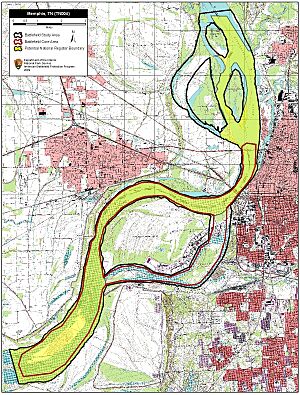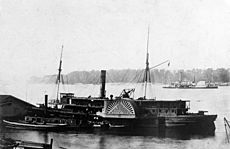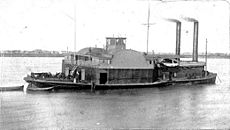First Battle of Memphis facts for kids
Quick facts for kids First Battle of Memphis |
|||||||
|---|---|---|---|---|---|---|---|
| Part of American Civil War | |||||||
 Battle of the rams. Ward, A. R., artist |
|||||||
|
|||||||
| Belligerents | |||||||
| Commanders and leaders | |||||||
| Units involved | |||||||
| Benton Louisville Carondelet Cairo St. Louis Ram Queen of the West Ram Monarch Ram Lancaster Ram Switzerland |
CSS General Beauregard CSS General Bragg CSS General Sterling Price CSS General Earl Van Dorn CSS General M. Jeff Thompson CSS Colonel Lovell CSS General Sumter CSS Little Rebel |
||||||
| Strength | |||||||
| 5 ironclads 4 rams |
8 rams | ||||||
| Casualties and losses | |||||||
| 1 ram disabled 1 wounded |
7 rams destroyed or captured approx. 100 killed or wounded approx. 150 captured |
||||||
The First Battle of Memphis was a big naval battle that happened on the Mississippi River. It took place just north of Memphis, Tennessee on June 6, 1862. This battle was part of the American Civil War. Many people from Memphis watched the fight from the riverbanks.
The battle was a huge loss for the Confederate forces. It almost completely wiped out their ships on the river. Even though the Union won easily, they didn't fully understand how important this victory was at first. This battle is historically important because it was the last time regular citizens, without military training, were allowed to command warships in a fight. It helped the United States Navy become more professional.
Contents
What Led to the Battle?
The Confederate and Union forces had similar numbers of ships. The Confederates had eight ships, and the Union had nine. But the Confederate ships were not as strong. Each Confederate ship had only one or two small guns. These guns were not powerful enough to damage the Union's armored ships. The main weapon for the Confederate ships was a strong front part, meant for ramming enemy ships.
Cottonclad Ships Explained
The Confederate ram ships had a special defense. Their engines and inside areas were protected by two thick walls of wood. The outside of these walls was covered with railroad iron. The space between the wooden walls, about 22 inches (56 cm), was filled with cotton. The cotton wasn't the most important part of the armor, but it got a lot of attention. Because of this, these ships were called "cottonclads". Later in the war, some ships used cotton bales to protect crews from small-arms fire. These were also called "cottonclads," but they were different from the original ones.
Union Ships and Their Design
The Union force had five gunboats. Four of these were known as "Eads gunboats," named after their builder, James Buchanan Eads. People also called them "Pook turtles" because of their designer, Samuel M. Pook, and their unusual look. The fifth gunboat, the flagship Benton, was also built by Eads but was changed from a civilian boat. Each of these gunboats carried 13 to 16 guns.
The other four Union ships were naval rams from the United States Ram Fleet. These ships had no guns, except for small weapons carried by their officers. All the rams were changed from civilian riverboats and had different designs.
How the Fleets Were Organized
Both sides had problems with how their ships were commanded. The Union gunboats were part of the Mississippi River Squadron. They were led by Flag Officer Charles H. Davis. He reported to Major General Henry W. Halleck. This meant the gunboats were part of the United States Army, even though their officers were from the navy.
The Union rams were led by Colonel Charles Ellet, Jr.. He reported directly to the Secretary of War Edwin M. Stanton. So, the Union "fleet" was actually two separate groups. They didn't have a single leader on the river, only back in Washington.
The Confederate command was even more confusing. The cottonclads were part of a group of fourteen river steamers. These had been taken in New Orleans and turned into rams to defend that city. This group was called the "River Defense Fleet." It was split in half when Confederate areas on the river were threatened. Six ships stayed near New Orleans, and eight were sent to Memphis. Memphis was seen as a shield for New Orleans.
The northern group (at Memphis) was led by James E. Montgomery, who was a riverboat captain before the war. The other boats were also commanded by former civilian captains chosen by Montgomery. None of them had military training. Once the battle started, Montgomery's command stopped, and the rams fought on their own. Military leaders knew this was a bad idea, but their warnings were ignored. Also, the captains wouldn't learn to use the guns themselves. So, gun crews had to come from the Confederate Army. These gunners were not part of the ship's regular crew and still took orders from their army officers.
Confederate Cottonclad River Defense Fleet
-
{Ex CSS} USS General Bragg probably photographed at Cairo or Mound City, Illinois, around 1862–63. -
{Ex CSS} USS General Price off Baton Rouge, LA, January 18, 1864
The Battle Begins
The Union victory at Corinth meant that the railroads connecting Memphis to the eastern Confederacy were cut. This made Memphis less important strategically. So, in early June 1862, the Confederate army left Memphis and its nearby forts. Most soldiers were sent to other places, like Vicksburg. Only a small group was left to put up a small fight.
The River Defense Fleet was also supposed to go to Vicksburg. But they couldn't get enough coal in Memphis. When the Union fleet showed up on June 6, the Confederate captains couldn't escape. They had to choose between fighting or sinking their own ships. They chose to fight. They steamed out early in the morning to meet the Union ships and rams. Citizens of Memphis cheered them on.
Fighting on the River
The battle began with shots fired from a distance. The Union gunboats formed a line across the river. They fired their rear guns at the cottonclads as they entered the fight. Two of the four Union rams went past the gunboats. They rammed or messed up the movements of the Confederate ships. The other Union rams didn't understand their orders and didn't join the fight.
Since the Union rams and gunboats weren't working together, and the Confederate ships were fighting on their own, the battle quickly became a messy free-for-all. Everyone agrees that the Union ram flagship, Queen of the West, started the main action. It crashed into CSS Colonel Lovell. Then, Queen of the West was rammed by one or more of the remaining cottonclads.
During this, Colonel Ellet was shot in the knee. He was the only Union soldier wounded in the battle. Sadly, he later got measles in the hospital. The illness combined with his wound was too much, and he died on June 21.
The Outcome of the Fight
The rest of the battle is a bit unclear because different people saw different things. But what is certain is that by the end of the battle, almost all the Confederate cottonclads were either destroyed or captured. Only one Union ship, Queen of the West, was disabled. The only Confederate ship to escape, CSS General Earl Van Dorn, fled to the Yazoo River, just north of Vicksburg.
Results of the Battle
The battle lasted less than two hours on the morning of June 6. By noon that day, the city of Memphis surrendered to the Union forces.
The Confederates had about 100 soldiers killed or wounded. Another 150 were taken prisoner. The Union forces captured and fixed four Confederate ships: CSS General Price, CSS General Bragg, CSS Sumter, and CSS Little Rebel. These ships were then added to the Union's Mississippi River Squadron.
The Battle of Memphis was the last major challenge to the Union's push down the Mississippi River towards Vicksburg. The river was now open all the way to Vicksburg. That city was already being attacked by Farragut's ships. However, the Union army leaders didn't fully understand how important this was for almost six more months. It wasn't until November 1862 that the Union Army, led by Ulysses S. Grant, tried to fully open the river.
Lessons Learned from the Battle
The poor performance of the River Defense Fleet at Memphis, and earlier at the Battle of New Orleans, showed something important. It proved that naval operations needed to be led by trained military professionals. The Ellet Rams stayed in Union service. But they didn't have another chance for the kind of combat they were built for. They soon became an amphibious raiding group called the Mississippi Marine Brigade. This group was led by Ellet's brother, Lieutenant Colonel (later Brigadier General) Alfred W. Ellet. The need for more professional soldiers also led to the end of privateering.
The Battle of Memphis is still a cautionary tale. It shows what happens when a command structure is poorly organized. It is also one of only two purely naval battles of the war (not counting single ship fights). It happened about 500 miles (805 km) from the nearest open ocean. The other purely naval battle was the Battle of Plum Point Bend, also on the Mississippi River.
Another Civil War battle happened in Memphis later. This was the Second Battle of Memphis in April 1864. In that battle, Confederate general Nathan Bedford Forrest led a nighttime cavalry raid on Memphis. He wanted to free Confederate prisoners and capture Union generals there. The raid failed in both goals. But it made the Union Army guard the area more carefully.




